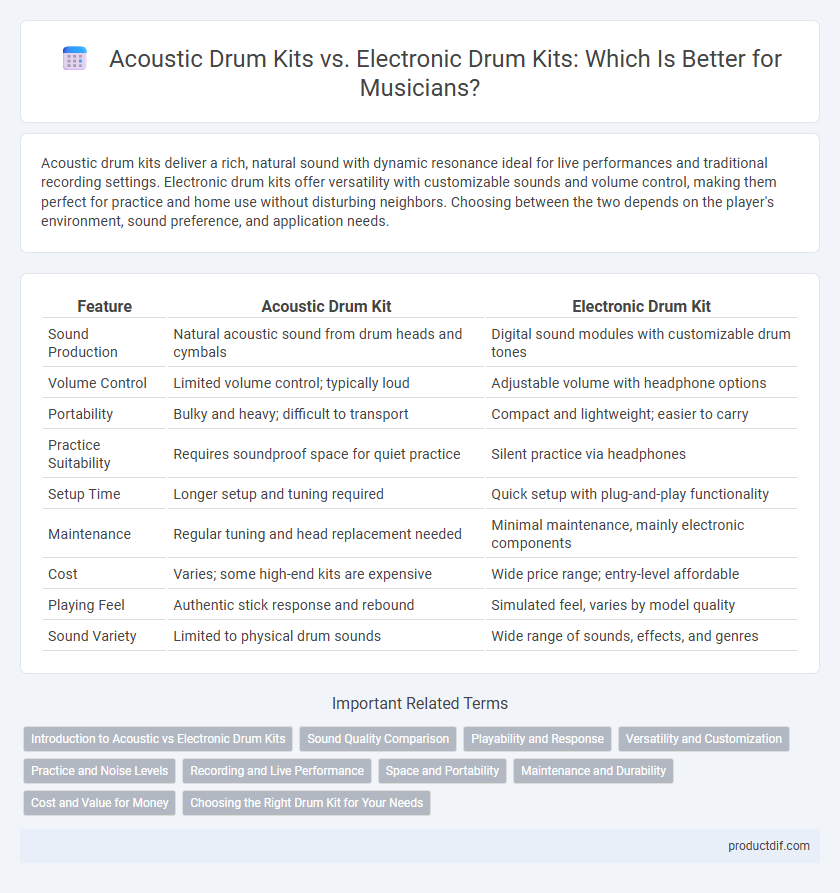Acoustic drum kits deliver a rich, natural sound with dynamic resonance ideal for live performances and traditional recording settings. Electronic drum kits offer versatility with customizable sounds and volume control, making them perfect for practice and home use without disturbing neighbors. Choosing between the two depends on the player's environment, sound preference, and application needs.
Table of Comparison
| Feature | Acoustic Drum Kit | Electronic Drum Kit |
|---|---|---|
| Sound Production | Natural acoustic sound from drum heads and cymbals | Digital sound modules with customizable drum tones |
| Volume Control | Limited volume control; typically loud | Adjustable volume with headphone options |
| Portability | Bulky and heavy; difficult to transport | Compact and lightweight; easier to carry |
| Practice Suitability | Requires soundproof space for quiet practice | Silent practice via headphones |
| Setup Time | Longer setup and tuning required | Quick setup with plug-and-play functionality |
| Maintenance | Regular tuning and head replacement needed | Minimal maintenance, mainly electronic components |
| Cost | Varies; some high-end kits are expensive | Wide price range; entry-level affordable |
| Playing Feel | Authentic stick response and rebound | Simulated feel, varies by model quality |
| Sound Variety | Limited to physical drum sounds | Wide range of sounds, effects, and genres |
Introduction to Acoustic vs Electronic Drum Kits
Acoustic drum kits consist of physical drums and cymbals that produce sound naturally through vibrating drumheads and shells, offering rich, dynamic tones ideal for live performances and traditional settings. Electronic drum kits use rubber or mesh pads with built-in sensors to trigger digital sounds, providing customizable kits, volume control, and headphone compatibility suited for home practice and recording. Both types cater to different needs, with acoustic kits favored for authentic sound and electronic kits prized for versatility and convenience.
Sound Quality Comparison
Acoustic drum kits deliver natural, rich, and dynamic sound with organic resonance that varies depending on drum size and material, providing authentic tonal depth favored by many professional drummers. Electronic drum kits offer adjustable sound profiles through digital sampling, allowing for consistent audio output and customizable effects, but may lack the nuanced acoustic warmth inherent in traditional drums. Advances in electronic drum technology continue to narrow the gap in sound realism, though acoustic kits remain the benchmark for authentic sound quality in live performances and recording.
Playability and Response
Acoustic drum kits offer a natural playability with authentic stick rebound and dynamic response, providing drummers with tactile feedback essential for nuanced expression. Electronic drum kits feature adjustable sensitivity and customizable response settings, allowing players to tailor the feel to personal preferences, though they may lack the organic resonance of acoustic sets. Both types cater to different playing environments and skill levels, with electronic kits often favored for quiet practice and acoustic kits preferred for live performance dynamics.
Versatility and Customization
Acoustic drum kits offer a natural sound and dynamic range favored by traditionalists, while electronic drum kits provide extensive versatility with customizable sounds and programmable features suited for diverse music styles. Electronic kits allow users to easily modify drum tones, switch kits instantly, and integrate with digital audio workstations for seamless production. Acoustic kits excel in organic feel and response but have limited sound variation compared to the infinite customization options available on electronic sets.
Practice and Noise Levels
Acoustic drum kits produce natural, resonant sounds but generate high noise levels, often requiring soundproofing for practice in shared spaces. Electronic drum kits offer adjustable volume with headphone compatibility, enabling quiet practice without disturbing others. The customizable sound settings on electronic kits also allow drummers to simulate various drum tones while minimizing noise pollution.
Recording and Live Performance
Acoustic drum kits deliver rich, natural sound textures preferred in live performances and studio recordings, capturing dynamic nuances through high-quality microphones. Electronic drum kits offer versatile sound options and easy volume control, making them ideal for silent practice and recording in noise-sensitive environments. Advanced electronic kits feature MIDI connectivity and customizable sound libraries, enhancing production flexibility for modern music sessions.
Space and Portability
Acoustic drum kits require significant space due to their multiple components, including large bass drums, toms, and cymbals, making them less ideal for small rooms or apartments. Electronic drum kits offer a compact design with fewer physical elements and adjustable volume, enhancing portability and suitability for limited spaces. Lightweight materials and foldable stands in electronic kits further simplify transportation and setup for musicians on the go.
Maintenance and Durability
Acoustic drum kits require regular tuning, head replacement, and care for wooden shells to maintain sound quality and structural integrity, making maintenance more hands-on and time-consuming. Electronic drum kits feature durable rubber or mesh pads that resist wear and require minimal upkeep, with fewer mechanical parts prone to damage. Both types depend on usage intensity, but electronic kits generally offer greater longevity and easier maintenance for consistent performance.
Cost and Value for Money
Acoustic drum kits typically cost between $300 and $3,000 depending on brand and quality, offering authentic sound and dynamic range that musicians value for live performances. Electronic drum kits, priced from $400 to $2,500, provide versatility with customizable sounds and quieter practice options, making them cost-effective for home use and recording. Choosing between them depends on budget priorities, sound preferences, and intended use, with acoustic kits excelling in natural tone and electronic kits delivering multifunctionality and silent practice benefits.
Choosing the Right Drum Kit for Your Needs
Selecting the right drum kit depends on your playing environment, sound preferences, and budget. Acoustic drum kits deliver authentic sound and dynamic feel, ideal for live performances and traditional settings, while electronic drum kits offer volume control, customizable sounds, and compact design suitable for practice and studio recording. Consider factors like space limitations, noise restrictions, and connectivity options to match the drum kit with your specific musical needs and goals.
Acoustic drum kit vs Electronic drum kit Infographic

 productdif.com
productdif.com